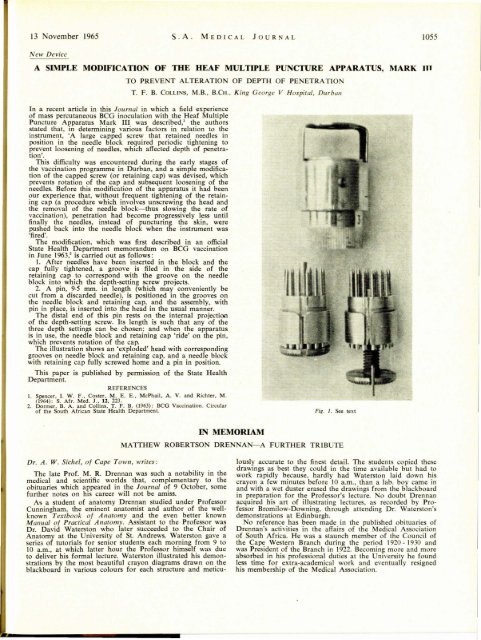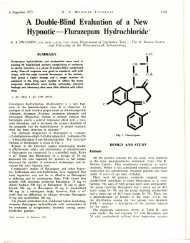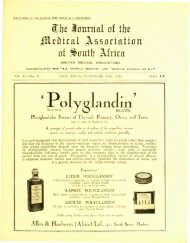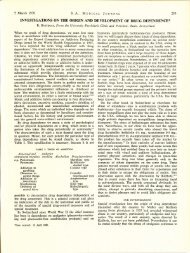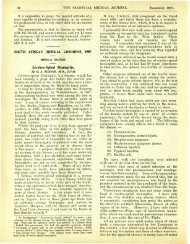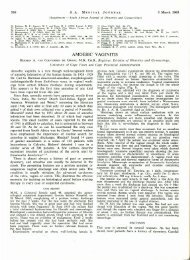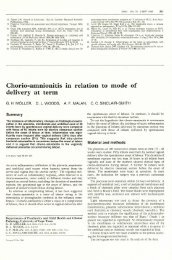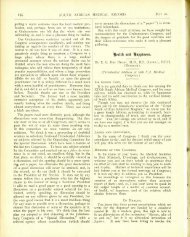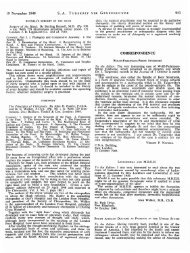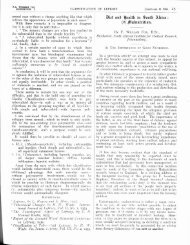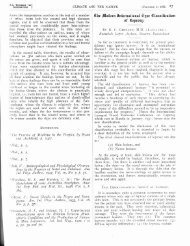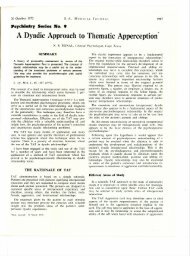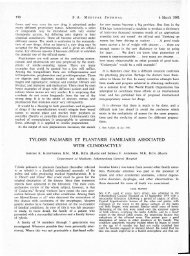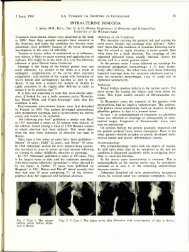2.9 IN MEMORIAM.pdf - SAMJ Archive Browser
2.9 IN MEMORIAM.pdf - SAMJ Archive Browser
2.9 IN MEMORIAM.pdf - SAMJ Archive Browser
You also want an ePaper? Increase the reach of your titles
YUMPU automatically turns print PDFs into web optimized ePapers that Google loves.
13 ovember 1965<br />
New Device<br />
S. A. M·E 0 I CA L J 0 URN A L 1055<br />
A SIMPLE MODIFICATION OF THE HEAF MULTIPLE PUNCTURE APPARATUS, MARK III<br />
TO PREVENT ALTERAno OF DEPTH OF PENETRATIO r<br />
In a recent article in this Journal in which a field experience<br />
of mass percutaneous BCG inoculation with the Heaf Multiple<br />
Puncture Apparatus Mark III was described,' the authors<br />
stated that, in determining various factors in relation to the<br />
instrument, 'A large capped screw that retained needles in<br />
position in the needle block required periodic tightening to<br />
prevent loosening of needles, which affected depth of penetration'.<br />
This difficulty was encountered during the early stages of<br />
the vaccination programme in Durban, and a simple modification<br />
of the capped screw (or retaining cap) was devised, which<br />
prevents rotation of the cap and subsequent loosening of the<br />
needles. Before this modification of the apparatus it had been<br />
our experience that, without frequent tightening of the retaining<br />
cap (a procedure which involves unscrewing the head and<br />
the removal of the needle block-thus slowing the rate of<br />
vaccination), penetration had become progressively less until<br />
finally the needles, instead of puncturing the skin, were<br />
pushed back into the needle block when the instrument was<br />
'fired'.<br />
The modification, which was first described in an official<br />
State Health Department memorandum on BCG vaccination<br />
in June 1963,' is carried out as follows:<br />
I. After needles have been inserted in the block and the<br />
cap fully tightened, a groove is filed in the side of the<br />
retaining cap to correspond with the groove on the needle<br />
block into which the depth-setting screw projects.<br />
2. A pin, 9·5 mm. in length (which may conveniently be<br />
cut from a discarded needle), is positioned in the grooves on<br />
the needle block and retaining cap, and the assembly, with<br />
pin in place, is inserted into the head in the usual manner.<br />
The distal end of this pin rests on the internal projection<br />
of the depth-setting screw. Its length is such that any of the<br />
three depth settings can be chosen; and when the apparatus<br />
is in use, the needle block and retaining cap 'ride' on the pin,<br />
which prevents rotation of the cap.<br />
The illustration shows an 'exploded' head with corresponding<br />
grooves on needle block and retaining cap, and a needle block<br />
with retaining cap fully screwed home and a pin in position.<br />
T. F. B. ColL<strong>IN</strong>S, M.B., B.CH .. King George V Hospiral, Durbal/<br />
This paper is published by permission of the State Health<br />
Department.<br />
REFERENCES<br />
I. Spencer, I. W. F., Coster, M. E. E., McPhail, A. V. and Richter, M.<br />
(1964): S. Afr. Med. J., 12, 223.<br />
2. Dormer. B. A. and Collins, T. F. B. (1963): BCG Vaccination. Circular<br />
of the South African State Health Department. Fig. r. See text<br />
Dr. A. W. Sichel, of Cape Town, wrires:<br />
<strong>IN</strong> <strong>MEMORIAM</strong><br />
MATTHEW ROBERTSON DRENNAN-A FURTHER TRIBUTE<br />
The late Prof. M. R. Drennan was such a notability in the<br />
medical and scientific worlds that, complementary to the<br />
obituaries which appeared in the Journal of 9 October, some<br />
further notes on his career will not be amiss.<br />
A'S a student of anatomy Drennan studied under Professor<br />
Cunningham, the eminent anatomist and author of the wellknown<br />
Textbook of Anatomy and the even better known<br />
Manual of Pracrical Anaromy. Assistant to the Professor was<br />
Dr. David Waterston who later succeeded to the Chair of<br />
Anatomy at the University of St. Andrews. Waterston gave a<br />
series of tutorials for senior students each morning from 9 to<br />
10 a.m., at which latter hour the Professor himself was due<br />
to deliver his formal lecture. Waterston illustrated his demonstrations<br />
by the most beautiful crayon diagrams drawn on the<br />
blackboard in various colours for each structure and meticu-<br />
lously accurate to the finest detail. The students copied these<br />
drawings as best they could in the time available but had to<br />
work rapidly because, hardly had Waterston laid down his<br />
crayon a few minutes before 10 a.m., than a lab. boy came in<br />
and with a wet duster erased the drawings from the blackboard<br />
in preparation for the Professor's lecture. No doubt Drennan<br />
acquired his art of illustrating lectures, as recorded by Professor<br />
Bromilow-Downing, through attending Dr. \Vaterston's<br />
demonstrations at Edinburgh.<br />
No reference has been made in the published obituaries of<br />
Drennan's activities in the affairs of the Medical Association<br />
of South Africa. He was a staunch member of the Council of<br />
the Cape Western Branch during the period 1920 - 1930 and<br />
was President of the Branch in 1922. Becoming more and more<br />
absorbed in his professional duties at the University he found<br />
less time for extra-academical work and eventually resigned<br />
his membership of the Medical Association.
1056 S.A. TYDSKRIF VIR GENEESKUNDE 13 November 1965<br />
The time has now arrived following the death of Professor<br />
Drennan to relate, if only for the record, an episode which<br />
hitherto had been regarded as strictly confidential. In 1952<br />
the Medical Association was in great difficulty with regard to<br />
finding a full-time editor of the Sourh African Medical Journal.<br />
Drennan, who at that time was approaching the normal retiring<br />
age as a professor, was interviewed and an offer made to him<br />
to be appointed Editor at a salary which to him must have<br />
been very attractive. After serious consideration, although<br />
there is no doubt that he would have been happy to accept,<br />
he felt that he was not sufficiently bilingual for the post. The<br />
then officials of the Head Office of the Association, while<br />
recognizing what Drennan himself stressed, nevertheless considered<br />
that his personality would compensate for any other<br />
shortcomings. They thereupon decided to send Drennan on a<br />
tour of the principal centres in the Union, ostensibly to meet<br />
members of the Association, but in reality to see how they<br />
would react to the proposed appointment. Drennan was received<br />
everywhere with great enthusiasm, especially by his old<br />
students, so much so that when he returned to Cape Town<br />
there seemed no reason why he should not accept the appointment.<br />
True to his character, when all seemed set he finally and<br />
firmly declined (for reasons which do not have to be explained<br />
here). It was typical of Drennan that at meetings where he<br />
took part in a debate and appeared to be completely in agreement<br />
with the proposal before the meeting, he would sayjust<br />
as the motion was about to be put to the vote-that after<br />
all there might be something to be said for the other point of<br />
view, and in this way the whole debate was re-opened.<br />
Another characteristic of his was the frequent repetition of<br />
words or a phrase while he was lecturing or addressing a<br />
meeting. He would say, for instance, 'Mr. Chairman, it is quite<br />
obvious to me-(pause)-it is quite obvious to me that .. .'<br />
In private conversation he was loquacious, very dogmatic<br />
and inclined to be critical of his colleagues. When the memorandum<br />
issued by the Royal College of Physicians on smoking<br />
and lung cancer appeared, I can remember him commentinj!<br />
that he was not at all convinced by what had been stated and<br />
that much more investigation was needed.<br />
Drennan was a man of outstanding ability, a clear thinker<br />
and a brilliant teacher who has left his mark on all those<br />
whom he taught and indeed on a much wider circle of<br />
personal friends. When he was able to relax from work he<br />
loved to potter about in the garden of his delightful home and<br />
to receive visitors. At one time he derived much pleasure from<br />
playing golf, and I can recall a particular occasion when he<br />
put in an unforgettable score which was duly celebrated in<br />
good old Scottish fashion.<br />
Mr. W. Lennox Gordon, of Cape Town, wrires:<br />
Professors Dart and Bromilow-Downing have paid tribute<br />
to the lute Matthew Robertson Drennan as a distinguished<br />
teacher and scientist at the University of Cape Town. No<br />
mention has been made of his brilliant academic career at<br />
Edinburgh University.<br />
He entered the Arts Faculty of the University with the<br />
George Heriot Classical Bursary, graduated M.A. Honours<br />
and was awarded the Neil Arnot prize in Natural Philosophy.<br />
From Arts he turned to Medicine and qualified in 1910, M.B.,<br />
Ch.B. with Distinction and Honours. The degree of M.D.<br />
followed, and in 1913 he became a Fellow of the Royal<br />
College of Surgeons, Edinburgh. In the Faculty of Medicine<br />
he was awarded 6 medals, 2 first prizes, 3 bursaries and the<br />
Buchanan Scholarship in Midwifery and Gynaecology which<br />
carried with it the resident appointment as house surgeon to<br />
the gynaecological wards of the Royal Infirmary, Edinburgh.<br />
In 1911 he was appointed full-time Demonstrator of Anatomy<br />
under Professor Robinson, which post he held till he<br />
sailed for South Africa, where he started as a general practitioner<br />
in Aliwal North. It was there that he met and later<br />
married Miss Susan de Wet.<br />
During the 1914 - 1918 War he saw service in South West<br />
Africa with the S.A.M.C. until a serious bout of enteric fever<br />
put an end to his military career.<br />
On Professor Thompson's retirement in 1919, Drennan was<br />
appointed to the Chair of Anatomy, and it was then that my<br />
association with him began, an association which extended<br />
beyond the Anatomy Department to sketching outings,<br />
archaeological expeditions and many other interests of this<br />
multi-faceted man. Proof of these wide interests and the value<br />
set on his expert knowledge and sound common sense is<br />
shown in the number of committees on which he served-the<br />
Medical Association of South Africa, the South African<br />
Museum, Michaelis Art School, Koopmans de Wet House, and<br />
the Red Cross Society, to name but a few.<br />
The style and purity of English used in his textbooks and<br />
many articles, scientific and popular, are a tribute to his early<br />
classical education, while the many anatomical models in the<br />
Anatomy Department bear witness to his skilful handicraft.<br />
To work with Drennan was stimulating-his views on anatomy.<br />
surgery, politics and men were stringent and refreshing.<br />
THE BICKERSTETH MEDICAL SOCIETY : DIE BICKERSTETH MEDIESE VERENIG<strong>IN</strong>G<br />
CL<strong>IN</strong>ICAL EVE I G, SOMERSET HOSPITAL, TUESDA Y 28 SEPTEMBER 1965<br />
Cases Presenied<br />
1. Dr. R. I. Samson presented a 76-year-old man with<br />
uraemia and pyelonephritis with a satisfactory response to<br />
rehydration and antibiotic therapy. The main interest of the<br />
case was in the associated congenital abnormalities, viz.<br />
kyphoscoliosis, apparent macroglossia, symmetrically large<br />
hands and feet due to excessive soft tissue, cutis laxa, hyperextensibility<br />
of the joints of the hands, a soft-tissue tumour of<br />
the right forearm, and cafe au lait. The skeletal X-rays showed<br />
generalized osteoarthritis and kyphoscoliosis. There was no<br />
family history of similar abnormalities, and no evidence of<br />
skin fragility.<br />
Dr. Samson reviewed the osteochondrodystrophies. Dr. L.<br />
Chanock and Dr. D. Stein suggested that the case was one of<br />
Ehlers-Danlos syndrome. Dr. . Shapiro thought that neurofibrcmatosis<br />
should be excluded by a biopsy of the forearm<br />
tumour although the symmetry of the abnormalities was<br />
against such diagnosis.<br />
2. Dr. M. Fredman presented a 4-year-old child with a<br />
I-week history of a tender swelling over the head of the<br />
fibula. On X-ray there was an osteolytic lesion with an overlying<br />
periosteal reaction, and an osteogenic sarcoma could not<br />
be excluded. A biopsy revealed only chronic inflammatory<br />
change. The subsequent Wassermann reaction of the child and<br />
mother was strongly positive.<br />
This is yet another instance of congenital syphilis as a reminder<br />
of the recent increasing incidence of venereal disease.<br />
PHARMACEUTICAL NEWS : FARMASEUTIESE NUUS<br />
C<strong>IN</strong>E AWARD WON BY ORTHO FOR FILM ON OBSTETRICS<br />
Ortho Pharmaceutical Corporation has won the ClNE Golden<br />
Eagle Award for the teaching film on childbirth 'Modern<br />
Obstetrics: ormal Delivery', which was judged as best of<br />
500 in the competition. Cl E (Council on International Tontheatrical<br />
Events) functions as a nOli-profit agency to judge<br />
American-made films and to select them for foreign showings<br />
and competitions.<br />
The film was produced under the joint sponsorship of the<br />
American Medical Association, the American College of<br />
Obstetricians and Gynecologists, and Ortho last year. It is the<br />
first approved teaching film on the subject since 1936.


